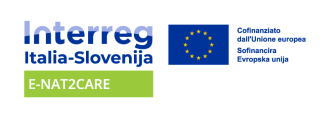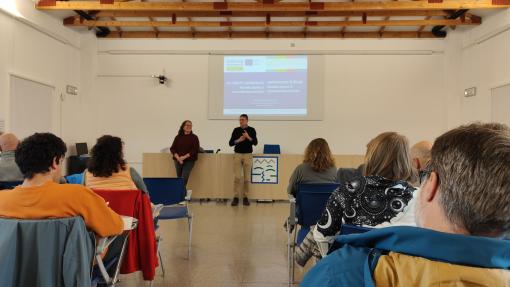On the afternoon of Thursday, 24 October 2024, a training workshop was held in Gemona del Friuli. The subject was the importance of the three target species of the two transboundary monitoring activites of the E-NAT2CARE project: Rosalia longicorn beetle (Rosalia alpina), ural owl (Strix uralensis) and hermit beetle (Osmoderma eremita). The event was aimed at researchers and the expert public - protected area managers, foresters and employees of forest management companies - with the goal of promoting the growth of professional skills to foster long-term cooperation.
After the customary greetings and introduction of the E-NAT2CARE project by the director of the Julian Prealps Nature Park Stefano Santi, Dr. Antonella Stravisi from the University of Udine began her speech with a general overview of saproxylic insects. She illustrated their life cycle and explained why the species prefer different types of dead wood. Afterwards, she presented the results achieved so far within the project and the expectations for the next monitoring campaign in summer 2025. As a treat for those present, the doctor brought along one of the traps used in the monitoring of the beetles and two samples of the pheromones used to attract them.
The next talk, by Dr Enrico Benussi and Dr Fulvio Genero, was on Strix uralensis, the Ural owl. The talk began with an overview of the historical presence of the species in Friuli Venezia Giulia, going from 23 reports in the period between 1850 and 1993 to the first nesting ascertained in 1994 on Mount Vogu near the Natisone Valley. The subsequent research activity, now spanning 30 years, started in the pre-alpine area and over time extended to the alpine area, more precisely in the Tarvisio area. These activities have yielded significant results, demonstrating that the ural owl is a widespread species that deserves more attention. Attention that must be translated into concrete protection and conservation actions, which are necessary to safeguard such important species. At the end of the lecture, a short documentary on the species made by Marco Favalli was screened, which can be viewed on the Julian Prealps Nature Park YouTube channel.
All the speakers highlighted the importance of proper forest management to safeguard these and other species, noting that not enough is currently being done. Hence the importance of awareness-raising and training events such as the one that took place on the afternoon of 24 October, to try to remedy this shortcoming in the near future.

